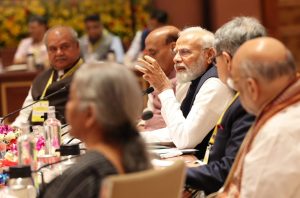Govt to scale up fortified rice in PDS; Niti Aayog to assess impact in 2024

By Our Special Correspondent
New Delhi, December 16: With 57 per cent women in the country being anemic, the Centre is scaling up the scope of the coverage of the fortified rice through the public distribution system (PDS), aiming to cover about 394 districts in the next six months. Niti Aayog will make an assessment of the impact of the fortified rice on the improvement of the nutrition level among women and children in two years after the scheme is fully rolled out.
Sources in the Ministry of Food said that the current focus is on the expansion and implementation by the states, as the Food Corporation of India (FCI) is scaling up the availability of fortified rice, which is a mixture of normal rice and machine made kernels of folic acid, iron and Vitamin B12. “Rice and kernels are mixed in 100:1 ration by machines to ensure that the poor people get the necessary supplements through the PDS. The Niti Aayog is monitoring the rollout of the plan by encouraging states to adopt the scheme,” said a senior official in the Ministry of Food.
The official also said while states like Madhya Pradesh and Uttar Pradesh are exceedingly doing well in the distribution of fortified rice, West Bengal and Odisha are lagging behind despite higher incidents of malnutrition among women and children there. “We are ramping up capacities to ensure that the states will get only fortified rice in the near future. The Indian Council of Agricultural Research (ICAR) has also been asked to work on fortified seeds, but the feedback from them suggests that the modified seeds will take some more years to materialise,” added the official.
The Niti Aayog had unveiled the Poshan (nutrition) Mission to tackle the incidents of malnutrition among children and women in the reproductive age group in the country. National Family Health Survey (NFHS) report (2019-21) had showed marginal improvements in the nutrition indicators for children under five years as compared with NFHS-4 (2015-16).
“The prevalence of stunting among the children under five years as per NFHS 5 survey has reduced from 38.4 per cent to 35.5 per cent. Further, the prevalence of anemia among all women of reproductive age group 15-49 years in the country as per the National Family Health Survey 5 (2019-21) is 57 per cent,” the government told the Lok Sabha on Friday.






